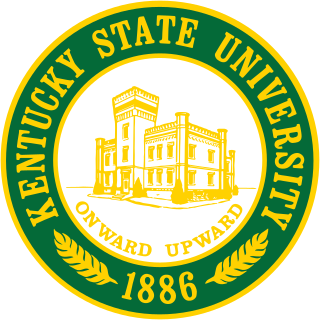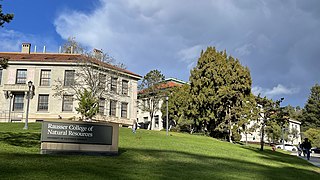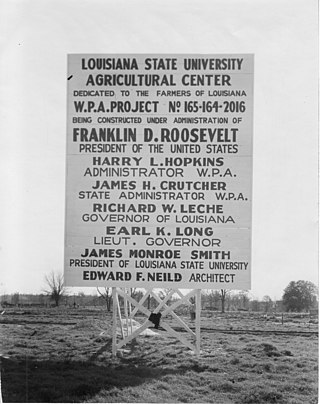
The University of Kentucky is a public land-grant research university in Lexington, Kentucky, United States. Founded in 1865 by John Bryan Bowman as the Agricultural and Mechanical College of Kentucky, the university is one of the state's two land-grant universities. It is the institution with the highest enrollment in the state, with 32,710 students in the fall of 2022.
The College of Agricultural and Environmental Sciences (Ag&E) is one of four colleges of the University of California, Davis. Established in 1922, it offers degrees in 27 undergraduate majors and thirty-three graduate groups. As of January 2014, the College has been overseen by Dean Helene Dillard.

Kentucky State University is a public historically black land-grant university in Frankfort, Kentucky. Founded in 1886 as the State Normal School for Colored Persons, and becoming a land-grant college in 1890, KSU is the second-oldest state-supported institution of higher learning in Kentucky. In fall 2019, total undergraduate enrollment was 2,029 with a total graduate enrollment of 142.

Lexington Theological Seminary is a private Christian seminary in Lexington, Kentucky. Although it is related to the Christian Church, it is intentionally ecumenical with almost 50 percent of its enrollment coming from other denominations. Lexington Theological Seminary is accredited by Association of Theological Schools in the United States and Canada to award Master of Divinity, Master of Theological Studies, Master of Pastoral Studies, and Doctor of Ministry degrees.
Gatton College of Business and Economics is a college of the University of Kentucky. Gatton College educates more than 4,000 undergraduate, master's, and doctoral students in accounting, economics, finance, management, and marketing and supply chain management. Founded in 1925 as the College of Commerce, the college was created from the Department of Economics and was given full accreditation by the Association to Advance Collegiate Schools of Business International. Initially the college occupied a single room in White Hall. In 1995, the Board of Trustees renamed the college in honor of Mr. Carol Martin "Bill" Gatton, '54, in recognition of his $14 million pledge. The donation was the largest in the history of the university. The current dean is Simon J. Sheather. The college is located in central campus along South Limestone. In Bloomberg Businessweek's 2024–2025 Business School ROI Calculator, Gatton ranked first in annual return-on-investment percentage.

The Rausser College of Natural Resources (RCNR), or Rausser College, is the oldest college at the University of California, Berkeley and in the University of California system. Established in 1868 as the College of Agriculture under the federal Morrill Land-Grant Acts, CNR is the first state-run agricultural experiment station. The college is home to four internationally top-ranked academic departments: Agriculture and Resource Economics; Environmental Science, Policy, and Management; Nutritional Sciences and Toxicology; and Plant and Microbial Biology, and one interdisciplinary program, Energy and Resources Group. Since February 2020, it is named after former dean and distinguished professor emeritus Gordon Rausser after his landmark $50 million naming gift to the college.

The University of Florida Institute of Food and Agricultural Sciences (UF/IFAS) is a teaching, research and Extension scientific organization focused on agriculture and natural resources. It is a partnership of federal, state, and county governments that includes an Extension office in each of Florida's 67 counties, 12 off-campus research and education centers, five demonstration units, the University of Florida College of Agricultural and Life Sciences, three 4-H camps, portions of the UF College of Veterinary Medicine, the Florida Sea Grant program, the Emerging Pathogens Institute, the UF Water Institute and the UF Genetics Institute.

The New Jersey Agricultural Experiment Station is an entity currently operated by Rutgers, The State University of New Jersey in conjunction with the State of New Jersey in the university's role as the state's sole land-grant university. Today, it conducts research in agriculture, horticulture and turf grass science, and through the Rutgers Cooperative Extension aids New Jersey farmers, landscapers, and residents in each of the state's twenty-one counties.
The Arkansas Agricultural Experiment Station (AAES) is the statewide research component of the University of Arkansas System's Division of Agriculture. The Division also includes the Cooperative Extension Service. The AAES and CES work together to develop and test new agricultural technology and extend it to the public. Research faculty and staff are based on five university campuses, at five Research and Extension Centers; six research stations and seven specialized units.
The University of Arkansas System Division of Agriculture is the agricultural research center for the University of Arkansas (UA).
The College of Agriculture and Life Sciences is one of eight colleges at Virginia Tech with a three-part mission of learning, discovery, and engagement and it is one of the best agriculture programs in the nation. It has more than 3,100 undergraduate and graduate students in a dozen academic departments. In 2013, the National Science Foundation ranked Virginia Tech No. 6 in the country for agricultural research expenditures, much of which originated from the College of Agriculture and Life Sciences.

The Louisiana State University Agricultural Center, or the LSU AgCenter, is an agriculture research center associated with the Louisiana State University System and headquartered in Baton Rouge, Louisiana. The center conducts agricultural-based research through its Louisiana Agricultural Experiment Station and extends the knowledge derived from research to the people of the state of Louisiana through its Louisiana Cooperative Extension Service. The LSU AgCenter, one of 11 institutions within the Louisiana State University System, shares physical facilities with the LSU A&M campus.
Abby Lindsey Marlatt, Ph.D. was a social justice activist and a teacher scholar committed to civic engagement. While a professor at the University of Kentucky (UK) in Lexington, Kentucky, she became the center of controversy at UK in the mid-1960s over anti-war protests and whether the university could censor her in her role as a public intellectual. She was honored for her work by many academic, professional and community organizations including the National Conference for Community and Justice, and she was inducted into the Kentucky Civil Rights Hall of Fame in 2001.
Carol Martin "Bill" Gatton was an American entrepreneur and philanthropist.
North Carolina State University's College of Agriculture and Life Sciences (CALS) is the fourth largest college in the university and one of the largest colleges of its kind in the nation, with nearly 3,400 students pursuing associate, bachelor's, master's and doctoral degrees and 1,300 on-campus and 700 off-campus faculty and staff members.
The University of Maryland College of Agriculture and Natural Resources is the agricultural and environmental sciences college of the University of Maryland and operates the Maryland Sea Grant College in cooperation with the University of Maryland Center for Environmental Science and the National Oceanic and Atmospheric Administration.
Mary E. Sweeney was a home economics professional who was head of the home economics section of the United States Food Administration during World War I. Sweeney was President of American Home Economics Association.

The Cooperative State Research, Education, and Extension Service (CSREES) was an extension agency within the U.S. Department of Agriculture (USDA), part of the executive branch of the federal government. The 1994 Department Reorganization Act, passed by Congress, created CSREES by combining the former Cooperative State Research Service and the Extension Service into a single agency.

The Lilongwe University of Agriculture and Natural Resources (LUANAR) is a university outside Lilongwe, Malawi. It was formed in 2011 by a merger between Bunda College of Agriculture of the University of Malawi and Natural Resources College (NRC).

The University of Connecticut's College of Agriculture, Health, and Natural Resources (CAHNR) is the oldest of UConn's fourteen colleges, and teaches a wide range of subjects. It is the oldest agricultural school in Connecticut, originally established with two purposes, conducting agriculture research and teaching practical skills to modernize farming. The college describes its mission as working "toward a global sustainable future." To that end, besides conducting research and teaching, the college's faculty also work together with Connecticut communities on projects related to food systems, agriculture, human health, nutrition and physical activity, and environmental science.










